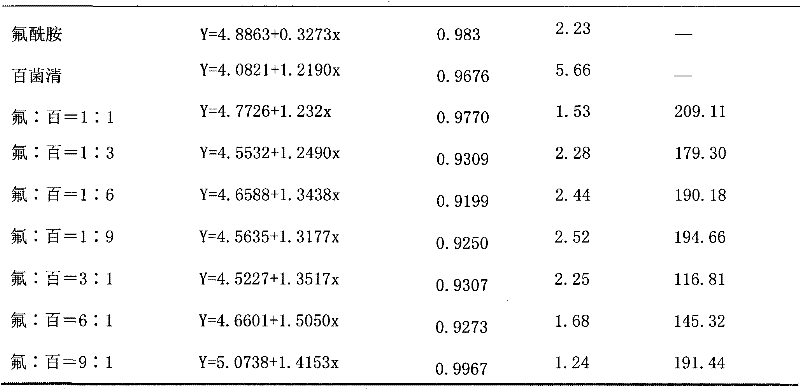Pesticide composition containing flutolanil and chlorothalonil
A composition, chlorothalonil technology, applied in the direction of bactericide, biocide, biocide, etc., to achieve excellent effect, improve bactericidal effect, and overcome resistance
- Summary
- Abstract
- Description
- Claims
- Application Information
AI Technical Summary
Problems solved by technology
Method used
Image
Examples
example 1
[0023] Physical Test Example 1: Toxicity Test of Fluoramide and Chlorothalonil against Rose Anthracnose
[0024] 1. Test object: rose anthracnose (Collectotrichum sp.), which is a common plant disease on roses, which affects the ornamental quality of roses and thus affects their sales in the market.
[0025] 2. Test method: refer to "Pesticide Bioassay Test Guidelines NY / T1156.14-2006", and use the drug-containing medium method.
[0026] 3. Statistical analysis of data: use SAS6.12 statistical software for analysis. Calculate the mycelia growth inhibition rate (%) according to the test data, and obtain the virulence regression equation, correlation coefficient (r), EC 50 and co-toxicity coefficient.
[0027] 4. Evaluation method: Refer to the "Pesticide Bioassay Test Guidelines", and evaluate the synergistic effect of drug mixture according to the co-toxicity coefficient method (CTC) of Sun & Johnson (1960), that is, CTC≤80 is antagonism, and 80<CTC<120 is antagonism. Addit...
example 2
[0034] Physical measurement example 2: Toxicity determination of flunamide and chlorothalonil against Phalaenopsis leaf spot
[0035] 1. Test object: Phalaenopsis leaf spot (Fusarium latertium f.celosia), which is a common plant disease on Phalaenopsis, affects the ornamental quality of Phalaenopsis, thereby affecting its sales in the market.
[0036] 2. Test method: Refer to the "Pesticide Bioassay Test Guidelines" and use the drug-containing medium method.
[0037] 3. Statistical analysis of data: use SAS6.12 statistical software for analysis. Calculate the mycelia growth inhibition rate (%) according to the test data, and obtain the virulence regression equation, correlation coefficient (r), EC 50 and co-toxicity coefficient.
[0038] 4. Evaluation method: Refer to the "Pesticide Bioassay Test Guidelines", and evaluate the synergistic effect of drug mixture according to the co-toxicity coefficient method (CTC) of Sun & Johnson (1960), that is, CTC≤80 is antagonism, and 80...
example 3
[0045] Physical measurement example 3: Toxicity determination of flunamide and chlorothalonil against camellia sooty disease
[0046] 1. Test object: Camellia sooty disease (Fumago sp.), which is a common plant disease on camellias, affects the ornamental quality of camellias, thereby affecting their sales in the market.
[0047] 2. Test method: refer to the "Pesticide Bioassay Test Guidelines NY / T 1156.2-2006", and use the drug-containing medium method.
[0048] 3. Statistical analysis of data: use SAS6.12 statistical software for analysis. Calculate the mycelia growth inhibition rate (%) according to the test data, and obtain the virulence regression equation, correlation coefficient (r), EC 50 and co-toxicity coefficient.
[0049] 4. Evaluation method: Refer to the "Pesticide Bioassay Test Guidelines", and evaluate the synergistic effect of drug mixture according to the co-toxicity coefficient method (CTC) of Sun & Johnson (1960), that is, CTC≤80 is antagonism, and 80
PUM
 Login to View More
Login to View More Abstract
Description
Claims
Application Information
 Login to View More
Login to View More - R&D Engineer
- R&D Manager
- IP Professional
- Industry Leading Data Capabilities
- Powerful AI technology
- Patent DNA Extraction
Browse by: Latest US Patents, China's latest patents, Technical Efficacy Thesaurus, Application Domain, Technology Topic, Popular Technical Reports.
© 2024 PatSnap. All rights reserved.Legal|Privacy policy|Modern Slavery Act Transparency Statement|Sitemap|About US| Contact US: help@patsnap.com










